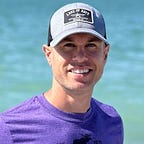The Best Exercise Routine for Your Brain
At this point we all know that exercise is good for us.
The health benefits of physical activity have been well-documented — including helping to control weight, strengthen the cardiovascular system, fortify bones, and reduce the risk of type 2 diabetes.
There is no doubt that the physical benefits of exercise are profound.
But the effects of exercise are perhaps most significant on the brain.
In fact, it is the mental benefits that have kept me running in the morning for over a decade now (the other health and fitness benefits are simply nice bonuses).
I swear by my morning run because it makes me sharper mentally all day long. And I am convinced that my morning running routine has changed my life and career more than any other habit.
The effects of exercise on my cognitive performance are so strong that I feel compelled to encourage others to take up a similar routine. But of course running isn’t for everyone, so I wanted to research the overall best types of exercise for the brain.
Fortunately, John Ratey M.D. is a leading expert in the space and wrote a best-selling book on the topic called Spark: The Revolutionary New Science of Exercise and the Brain.
In the book, Ratey calls exercise “the single most powerful tool you have to optimize your brain function.”
He points out that exercise has been proven to:
- Improve learning ability and grow brain cells
- Alleviate stress, anger, anxiety, and depression
- Increase focus, attention, and alertness
- Reduce the risk of age-related disorders such as Alzheimer’s, Parkinson’s, and other forms of Dementia
And he details the best exercise regimen for optimal brain performance:
- At a minimum, we should be following the Public Heath recommendations which call for some type of moderate-intensity aerobic activity for 30 minutes at least 5 days a week.
- Going a step further, it is best to do some form of aerobic activity 6 days a week, for 45 minutes to 1 hour. Go on the longer side for 4 of the days at moderate intensity (65–75% of your maximum heart rate), and then 2 of the days should be on the shorter side at high intensity (75–90%). Make sure not to do the high-intensity days back-to-back in order to let your body and brain recover.
- For your aerobic exercise, activities like running, cycling, or swimming are great, but the best type of aerobic activity is really whatever you will truly be able to build into your lifestyle. If you haven’t been active in a while, the best way to begin is to start walking.
- On your shorter, high-intensity days, add some form of strength or resistance training to build muscles, strengthen bones, and protect joints (do 3 sets of your exercises at weights that allows you to do 10–15 repetitions in each set).
- Make efforts to mix in more complex activities that will build skills, challenge the brain, and help you stay agile — for example rock climbing, martial arts, gymnastics, dance, yoga, pilates, or balance drills. Racket sports are especially great because they simultaneously tax the cardiovascular system and the brain. According to Ratey, “The combination of challenging the brain and body has a greater positive impact than aerobic exercise alone.”
- Consider joining an exercise group to get going and keep you on track. Social interaction is great for health, reduces stress, and boosts motivation. “Exercise cues up the building blocks of learning, and social interaction cements them in place,” says Ratey.
Overall, Ratey’s advice for people is to “get fit and then continue challenging themselves.” He advises to do something almost every day, but keep your program flexible and keep adapting to try new things.
There is no doubt that exercise is incredibly powerful for both the mind and body.
We’re awake for at least 16 hours each day. Spending just one of those hours (or even half an hour) exercising will be the most important thing you do all day!
If you enjoyed this post, please click the “clap” button below to let me know, and to help other people see it as well. Thank you!
Andrew Merle writes about living well, including good habits for happiness, health, productivity, and success. Subscribe to his e-mail list at andrewmerle.com and connect with him on Twitter.
